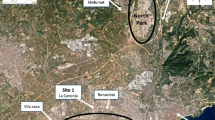Summary
All emissions from incomplete combustion contain polycyclic aromatic hydrocarbons (PAH) which are a well-known class of carcinogens. The question whether additional carcinogenic compounds do exist in these emissions can be answered by separating the emission condensate into a PAH-containing and a PAH-free part. These parts have been tested in an animal experiment by means of a carcinogen-specific test system such as topical application onto the skin of mice or injection into the lung of rats. The investigation on the contribution of PAH-fractions and of benzo(a)pyrene to the carcinogenic potential of emission condensate from gasoline driven engines, Diesel engines, coal combustion in domestic furnaces and sidestream smoke of cigarettes shows that the carcinogenic effect of the particle phase of these pyrolytic condensates is predominantly caused by polycyclic aromatic compounds such as PAH. In all cases investigated the PAH-fraction containing 4 and more rings accounted for more than 75% of the total carcinogenic effect resulting from the implantation into the lung of rats or from the topical application onto mouse skin. The contribution of benzo(a)pyrene to the carcinogenic potency of various condensates, however, is minor in all cases investigated and accounts for only 0.17% to 4% of the total carcinogenicity as evaluated from implantation into the lung of rats (Table 1).
Similar content being viewed by others
References
Deutsch-Wenzel R, Brune H, Grimmer G (1983) Cancer Lett 20:97–101
Deutsch-Wenzel R, Brune H, Grimmer G, Dettbarn G, Misfeld J (1983) JNCI 71:539–544
Stanton MF, Miller E, Wrench C, Blackwell R (1972) JNCI 49:867–877
Grimmer G, Brune H, Deutsch-Wetzel R, Dettbarn G, Jacob J, Naujack K-W, Mohr U, Ernst H (1987) Cancer Lett 37:173–180
Grimmer G, Brune H, Deutsch-Wenzel R, Naujack K-W, Misfeld J, Timm J (1983) Cancer Lett 21:105–113
Grimmer G, Brune H, Deutsch-Wenzel R, Dettbarn G, Misfeld J (1984) JNCI 72:733–739
Grimmer G, Brune H, Deutsch-Wenzel R, Dettbarn G, Misfeld J, Abel U, Timm J (1984) Cancer Lett 23:167–176
Grimmer G, Brune H, Deutsch-Wenzel R, Dettbarn G, Misfeld J, Abel U, Timm, J (1985) Cancer Lett 28:203–211
Grimmer G, Brune H, Deutsch-Wenzel R, Dettbarn G, Misfeld J (1987) JNCI 78:935–941
Schmidt W, Grimmer G, Jacob J, Dettbarn G (1986) Toxicol Environm 13:1–16
Schmidt W, Grimmer G, Jacob J, Dettbarn G, Naujack K-W (1987) Fresenius Z Anal Chem 326:401–413
Grimmer G, Brune H, Dettbarn G, Naujack K-W, Mohr U, Wenzel-Hartung, R. (1988) Cancer Lett 43:173–177
Author information
Authors and Affiliations
Rights and permissions
About this article
Cite this article
Grimmer, G., Brune, H., Dettbarn, G. et al. Relevance of polycyclic aromatic hydrocarbons as environmental carcinogens. Fresenius J Anal Chem 339, 792–795 (1991). https://doi.org/10.1007/BF00321747
Received:
Issue Date:
DOI: https://doi.org/10.1007/BF00321747




